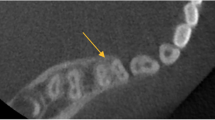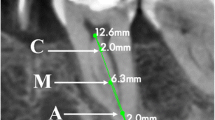Abstract
Objectives
Microorganisms in untreated or overlooked root canals can cause endodontic failure or infection and inflammation. Therefore, clinicians should familiarize themselves with patient’s root canal anatomy and morphology. The objective of this retrospective study was to analyze and characterize mandibular root canal morphology using cone beam computed tomography (CBCT) in a Turkish Cypriot population.
Materials and methods
This cross-sectional study consisted of retrospective evaluation of CBCT scans from 272 adult patients (aged 16–80 years). The number of roots and canals and the canal configuration in each root were evaluated using Vertucci’s classification. The incidence of additional roots and of C-shaped canals in the mandibular first and second molars was also noted. Pearson chi-square tests were performed to analyze canal configurations, laterality, and gender (p ≤ 0.05).
Results
For the female and male patients, 94.5 and 94.4 % of the mandibular first and 96.7 and 97.2 % of the mandibular second molars had two roots, respectively. In females, 4.4 % of mandibular first molars had three roots versus 2.7 % of mandibular first molars in male patients. Type IV was the most prevalent canal configuration regardless of the gender (female 61.3 % and male 64.2 %) in the mesial roots. No statistically significant differences according to gender or laterality were found in the incidence of additional canals for either maxillary first or second molars.
Conclusions
Type IV was the most prevalent canal configuration of both the mandibular first and second molar teeth. There was a low prevalence of three-rooted mandibular molars in this particular population.
Clinical relevance
The current study is the first of its kind to include a Turkish Cypriot population and, thus, provides baseline data for these patients regarding appropriate root canal treatments.



Similar content being viewed by others
References
Siqueira JF Jr (2001) Aetiology of root canal treatment failure: why well-treated teeth can fail. Int Endod J 34:1–10
Friedman S (2002) Considerations and concepts of case selection in the management of post-treatment endodontic disease (treatment failure). Endod Top 1:54–78
Witherspoon DE, Small JC, Regan JD (2013) Missed canal systems are the most likely basis for endodontic retreatment of molars. Tex Dent J 130:127–139
Hartwell G, Appelstein CM, Lyons WW, Guzek ME (2007) The incidence of four canals in maxillary first molars: a clinical determination. J Am Dent Assoc 138:1344–1346
Barbizam JV, Ribeiro RG, Tanomaru Filho M (2004) Unusual anatomy of permanent maxillary molars. J Endod 30:668–671
England MC Jr, Hartwell GR, Lance JR (1991) Detection and treatment of multiple canals in mandibular premolars. J Endod 17:174–178
Slowey RR (1979) Root canal anatomy. Road map to successful endodontics. Dent Clin N Am 23:555–573
Al-Qudah AA, Awawdeh LA (2009) Root and canal morphology of mandibular first and second molar teeth in a Jordanian population. Int Endod J 42:775–784
Gulabivala K, Opasanon A, Ng YL, Alavi A (2002) Root and canal morphology of Thai mandibular molars. Int Endod J 35:56–62
Sert S, Aslanalp V, Tanalp J (2004) Investigation of the root canal configurations of mandibular permanent teeth in the Turkish population. Int Endod J 37:494–499
Chen G, Yao H, Tong C (2009) Investigation of the root canal configuration of mandibular first molars in a Taiwan Chinese population. Int Endod J 42:1044–1049
Al-Nazhan S (1999) Incidence of four canals in root-canal-treated mandibular first molars in a Saudi Arabian sub-population. Int Endod J 32:49–52
Demirbuga S, Sekerci AE, Dincer AN, Cayabatmaz M, Zorba YO (2013) Use of cone-beam computed tomography to evaluate root and canal morphology of mandibular first and second molars in Turkish individuals. Medicina Oral Patología Oral y Cirugia Bucal e737-e44
Weine FS, Pasiewicz RA, Rice RT (1988) Canal configuration of the mandibular second molar using a clinically oriented in vitro method. J Endod 14:207–213
Bram SM, Fleisher R (1991) Endodontic therapy in a mandibular second bicuspid with four canals. J Endod 17:513–515
Raisingani D, Gupta S, Mital P, Khullar P (2014) Anatomic and diagnostic challenges of C-shaped root canal system. Int J Clin Pediatr Dent 7:35–39
Al-Fouzan KS (2002) C-shaped root canals in mandibular second molars in a Saudi Arabian population. Int Endod J 35:499–504
Sert S, Bayirli GS (2004) Evaluation of the root canal configurations of the mandibular and maxillary permanent teeth by gender in the Turkish population. J Endod 30:391–398
Corzon M (1974) Miscegenation and the prevalence of three-rooted mandibular first molars in the Baffin Eskimo. Community Dent Oral Epidemiol 2:130–131
Ok E, Altunsoy M, Nur BG, Aglarci OS, Colak M, Gungor E (2014) A cone-beam computed tomography study of root canal morphology of maxillary and mandibular premolars in a Turkish population. Acta Odontol Scand 72:701–706
Committee HA (2011) Implications for the justice and home affairs area of the accession of Turkey to the European Union. The Stationery Office p Ev 34
Turkish Statistical Institute(TurkStat), 2014 National population counts, Ankara
Vertucci FJ (1984) Root canal anatomy of the human permanent teeth. Oral Surg Oral Med Oral Pathol 58:589–599
Chang PC, Liang K, Lim JC, Chung MC, Chien LY (2013) A comparison of the thresholding strategies of micro-CT for periodontal bone loss: a pilot study. Dentomaxillofac Radiol 42(2):66925194. doi:10.1259/dmfr/66925194
Zare Jahromi M, Jafari Golestan F, Mashhadi Esmaeil M, Moouavizahed S, Sarami M (2013) Root and canal morphology of mandibular second molar in an Iranian population by clearing method. J Dent (Shiraz) 14:78–81
Nur BG, Ok E, Altunsoy M, Aglarci OS, Colak M, Gungor E (2014) Evaluation of the root and canal morphology of mandibular permanent molars in a south-eastern Turkish population using cone-beam computed tomography. Eur J Dent 8:154–159
de Souza-Freitas JA, Lopes ES, Casati-Alvares L (1971) Anatomic variations of lower first permanent molar roots in two ethnic groups. Oral Surg Oral Med Oral Pathol 31:274–278
Fabra-Campos H (1985) Unusual root anatomy of mandibular first molars. J Endod 11:568–572
Zhang R, Yang H, Yu X, Wang H, Hu T, Dummer PM (2011) Use of CBCT to identify the morphology of maxillary permanent molar teeth in a Chinese subpopulation. Int Endod J 44:162–169
Caliskan MK, Pehlivan Y, Sepetcioglu F, Turkun M, Tuncer SS (1995) Root canal morphology of human permanent teeth in a Turkish population. J Endod 21:200–204
Cimilli H, Cimilli T, Mumcu G, Kartal N, Wesselink P (2005) Spiral computed tomographic demonstration of C-shaped canals in mandibular second molars. Dentomaxillofac Radiol 34:164–167
Lambrianidis T, Lyroudia K, Pandelidou O, Nicolaou A (2001) Evaluation of periapical radiographs in thE recognition of C-shaped mandibular second molars. Int Endod J 34:458–462
Census, 1973. Department of statistics and research, Cyprus, Nicosia
Conflict of interest
The authors declare that they have no competing interests.
Funding source
No funding was secured for this study.
Ethical approval
All procedures performed in studies involving human participants were in accordance with the ethical standards of the institutional and/or national research committee and with the 1964 Helsinki Declaration and its later amendments or comparable ethical standards. This study was funded by YDU/2015/28-183.
Informed consent
Informed consent was obtained from all individual participants included in the study.
Author information
Authors and Affiliations
Corresponding author
Rights and permissions
About this article
Cite this article
Celikten, B., Tufenkci, P., Aksoy, U. et al. Cone beam CT evaluation of mandibular molar root canal morphology in a Turkish Cypriot population. Clin Oral Invest 20, 2221–2226 (2016). https://doi.org/10.1007/s00784-016-1742-2
Received:
Accepted:
Published:
Issue Date:
DOI: https://doi.org/10.1007/s00784-016-1742-2




